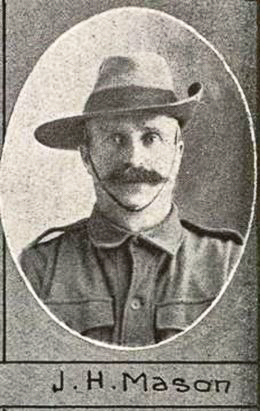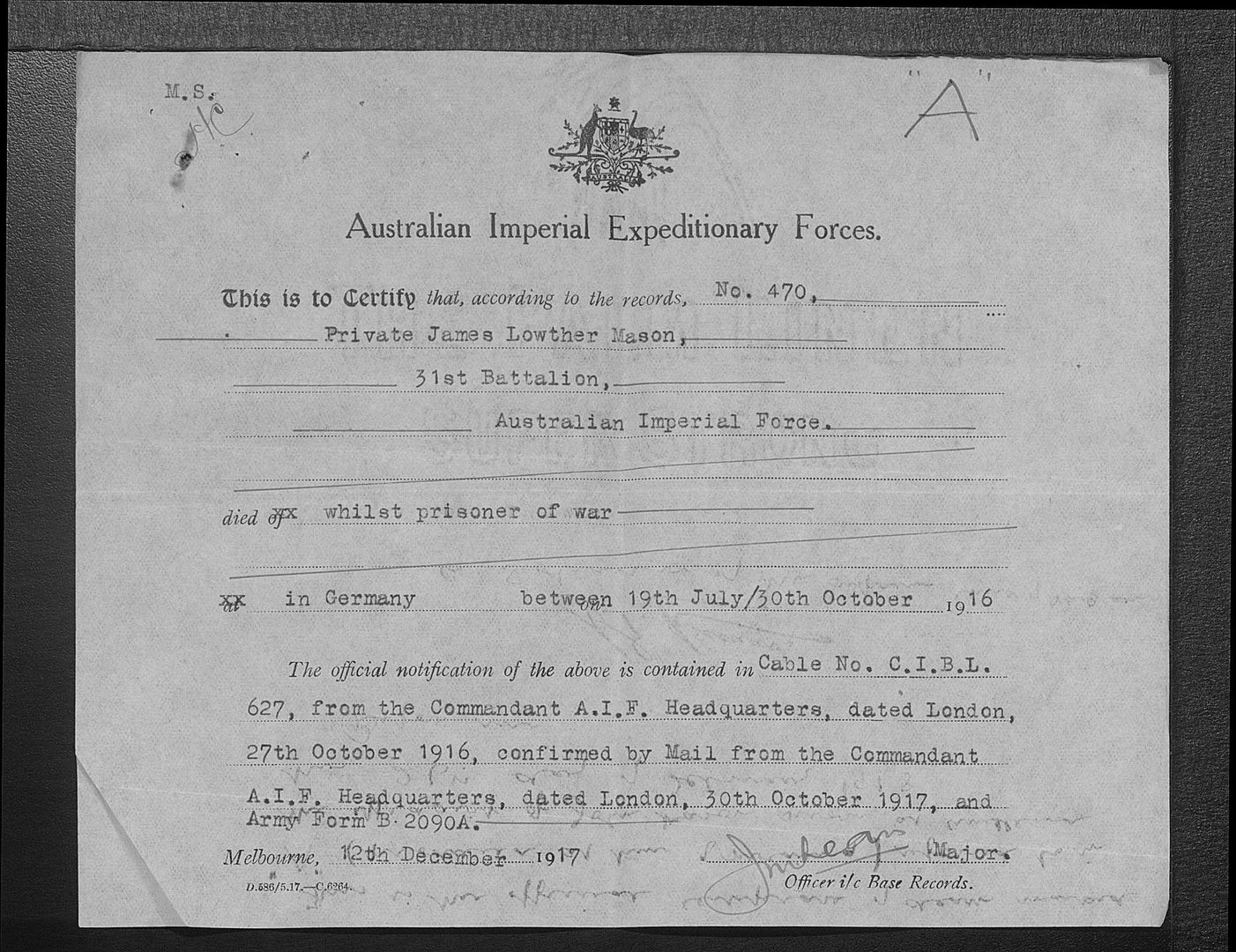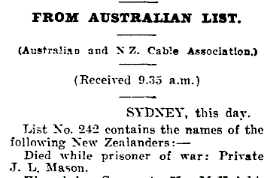James Lowther MASON
Eyes Blue, Hair Auburn, Complexion Fresh
New Zealand Born -- James Lowther Mason
Can you help us identify James?
James died following the Battle of Fromelles. As part of the 31st Battalion he was positioned near where the Germans collected soldiers that were later buried at Pheasant Wood. There is a chance he might be identified, but we need help. We are still searching for suitable family DNA donors.
In 2008 a mass grave was found at Fromelles, a grave that the Germans dug for 250 (Australian) bodies they recovered after the battle.
If you know anything of contacts here in Australia or his relatives from New Zealand or England, please contact the Fromelles Association.
See the DNA box at the end of the story for what we do know about his family.
Family Background
James Lowther Mason was the seventh of John and Margaret (Lowther) Mason’s twelve children. He was born in 1873 in Christchurch, New Zealand.
John and Margaret Mason had arrived in Canterbury, New Zealand on 14 Dec 1861 on the ship Sebastopol. John’s family was from Dent in South Yorkshire, while Margaret was from Penrith, Cumbria. John has early success on the goldfields at Jones Creek, which gave him enough of a return to purchase farmland and the family settled in the Styx, Belfast area north of Christchurch where John was a farm labourer. Life was tough and by 1880 John was declared insolvent. He managed to retain his farm and the family moved in 1883 to the North Island where they continued farming for a number of years. John eventually retired in 1905 and moved to Auckland and passed away in 1910. Margaret would live til 1918.
The family settled in the Styx, Belfast area of North Christchurch and expanded their family to 12, all believed to survive to adulthood.
Children of John, 1836-1910 and Margaret, 1838-1918.
- Jane 1860 in England, died NZ
- John (Jack) 1862- 1940 Christchurch (NOK to James)
- William 1866
- Edward 1867
- Robert William 1869-1957
- Mary 1870-1917
- James Lowther 1873-1916
- Elizabeth 1875-1959
- Margaret 1876
- Thomas 1878
- Colin 1879-1939
- Ann 1880-1934
James migrated to Australia, initially in Sydney around 1910, before moving up the coast to Bundaberg. In the 1914 electoral roll he was a labourer living in Bundaberg, Queensland.
Into the Australian Army and Off to Egypt
While at 42 years and 7 months old James was close to the maximum age to enlist, he signed up for the War effort on 13 July 1915 at Brisbane, Queensland and was assigned to the 31st Battalion, B Company. The 31st Battalion was formed with two companies from Queensland and two companies from Victoria. All were joined at Broadmeadows in Victoria before departing. Just before sailing from Melbourne on 9 November aboard the troopship Wandilla, the 991 soldiers of the 31st had been on parade in Melbourne in front of a good crowd.
In the Weekly Times, the Minister for Defence, H.F. Pearce said:
“I do not think I have ever seen a finer body of men.”
The Wandilla docked at Port Suez exactly four weeks after leaving Melbourne.
Their initial assignments were in Serapeum until near the end of February. When they left Serapeum to Tel el Kebir, they were moved for the 60 km trip in “dirty horse trucks”. At the end of March they were moved to Ferry Post and the Duntroon camps for training and guarding the Suez Canal, before moving to Moascar at the end of May.
The months passed in training and sightseeing, but by the time the 31st Battalion was transferred to France, the men were all heartily sick of Egypt. Private Les Smith’s (934) letter home pretty well sums it up.
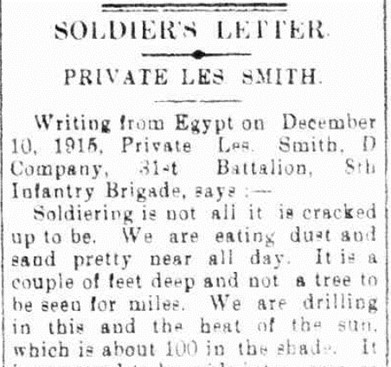
The Western Front – Fromelles
On 15 June, the 31st Battalion began to make their way to the Western Front, first by train from Moascar to Alexandria and then aboard the troopship Hororata, sailing to Marseilles. After disembarking on 23 June, they took trains to Steenbeque and marched to Morbecque, 35 km from Fleurbaix, arriving on 26 June. The battalion strength was 1019 soldiers.
Training continued, with how to handle poisonous gas now included in their regimen. They began their move towards Fleurbaix on 8 July and by 11 July they were into the trenches for the first time, in relief of the 15th Battalion. They were relieved by the 4th NZ on the 16th.
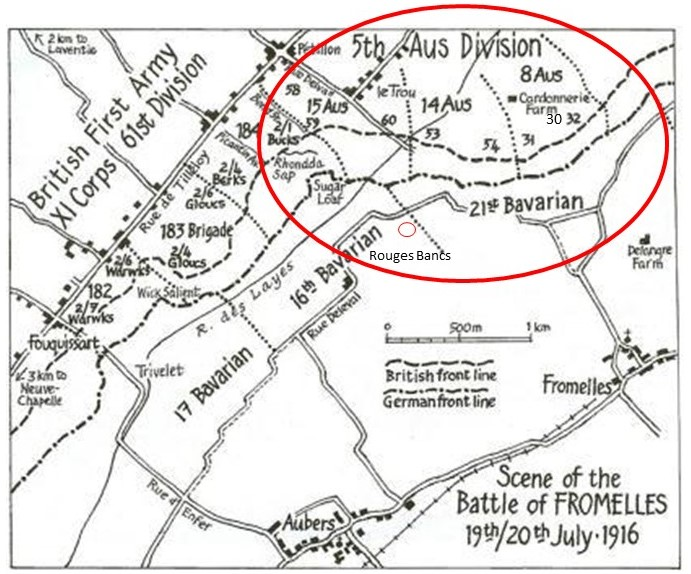
The original attack was planned for the 17th, but bad weather caused it to be postponed.
On the 19th they were back into the trenches and in position at 4:00 PM:
“Just prior to launching the attack, the enemy bombardment was hellish, and it seemed as if they knew accurately the time set.”
The assault began at 5:58 PM and they went forward in four waves, A and C Company in the first two waves and James’ B Company and D Company in the 3rd and 4th waves. The pre battle bombardment did have a big impact and by 6:30 PM the Aussies were in control of the German’s 1st line system (Trench B in the diagram below), which was described as “practically a ditch with from 1 to 2 feet of mud and slush at the bottom”. Source AWM4 23/49/12, 32nd Battalion War Diaries, July 1916, page 11
Unfortunately, with the rapid success of their attack, ‘friendly’ artillery fire caused a large number of casualties.
By 8:30 PM the Australians’ left flank had come under heavy bombardment with high explosives and shrapnel. Return bombardment support was provided and the 32nd was told that “the trenches were to be held at all costs”. Source AWM4 23/49/12, 32nd Battalion War Diaries, July 1916, page 12
Fighting continued through the night. The Australians made a further charge at the main German line beyond Trench B, but they were low on grenades, there was machine gun fire from behind from the emplacement at Delangre Farm and they were so far advanced that they were getting shelled by both sides.
At 4:00 AM the Germans began an attack from the Australian’s left flank, bombing and advancing into Trench A (map). Given the Australian advances that had been made earlier, portions of the rear Trench E had been left almost empty, which then enabled the Germans to be in a position to surround the soldiers.
At 5:30 AM the Germans attacked from both flanks in force and with bombing parties. Having only a few grenades left, the only resistance the 31st could offer was with rifles:
“The enemy swarmed in and the retirement across No Mans’ Land resembled shambles, the enemy artillery and machine guns doing deadly damage.”
The 31st were out of the trenches by the end of the day on the 20th. From the 1019 soldiers who left Egypt, the initial impact was assessed as 72 soldiers killed, 581 wounded and 85 were missing. The ultimate total was that 161 soldiers were either killed or died from wounds and of this total 82 were missing/unidentified. To date (2024), 23 of those missing have been later identified and are buried in the Pheasant Wood Cemetery.
The bravery of the soldiers of the 31st was well recognised by their own Battalion commanders.
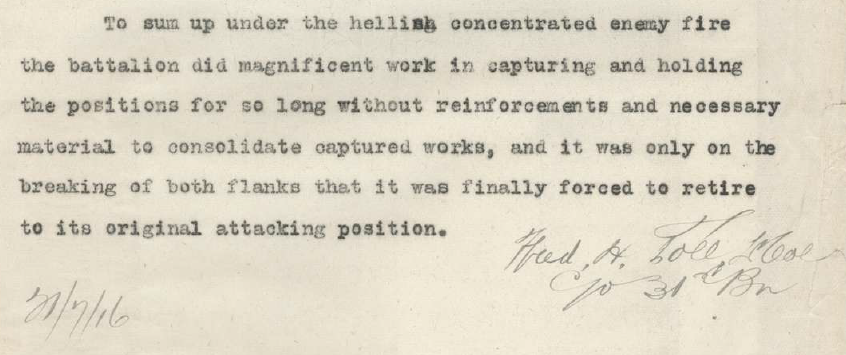
What Happened to James?
Exactly what happened to James is unknown, as there are no Red Cross Missing and Wounded witness statements for him. He is on the German Death list, noted as “gefallen” on 19 July 1916, which was often used for the bodies and ID tags that the Germans recovered after the battle.
However, he was reported as a Prisoner of War and in September 1916 the Germans returned his personal items, which contained some German Marks in his pockets.
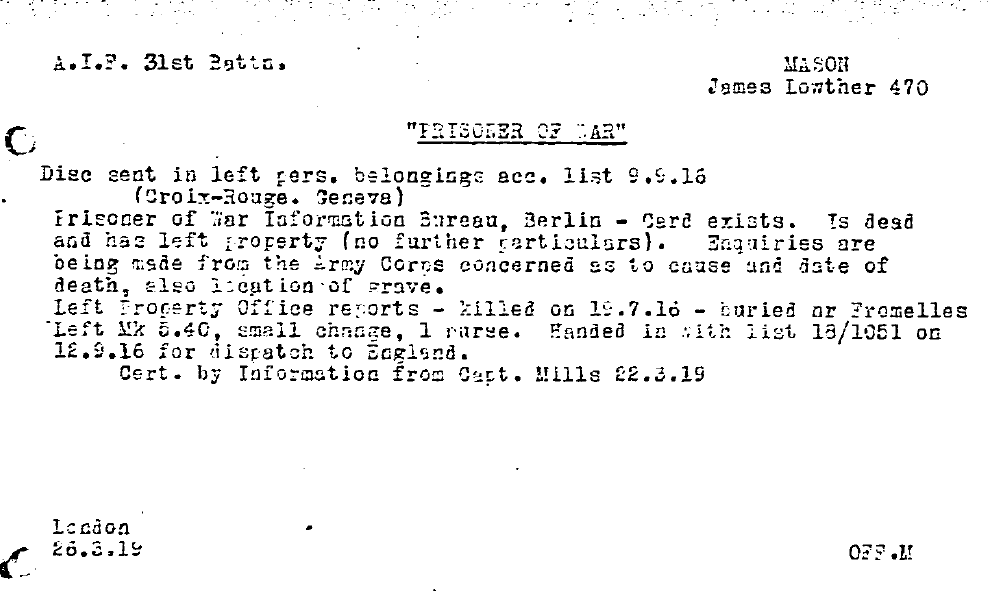
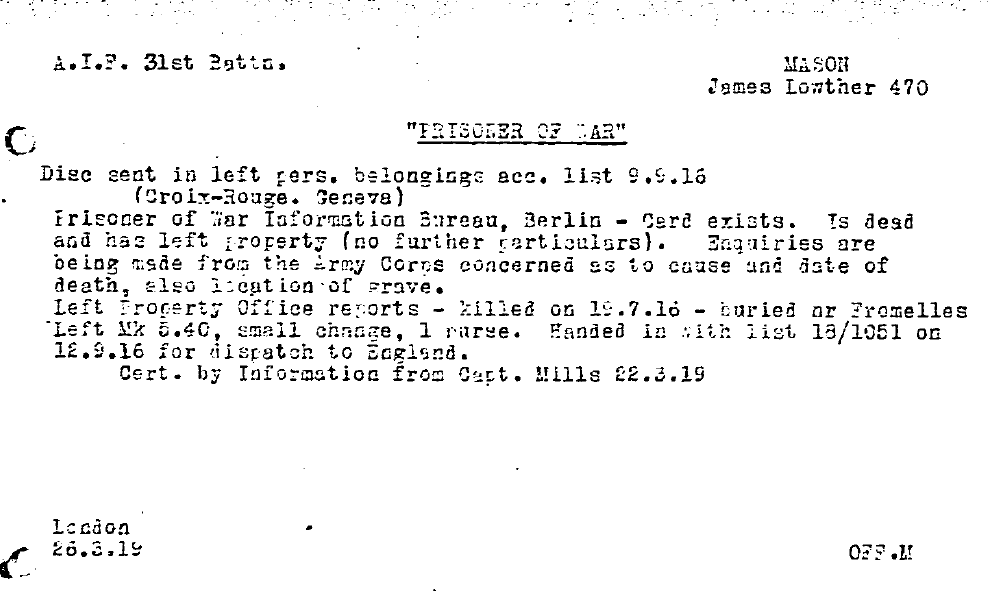
Notice Regarding James’ Death
It is also possible that James did die in the battle and that he was buried in the vicinity after the Germans recovered his personal goods.
James was awarded the British War Medal, the Victory Medal and the 1914/15 Star Medal.
James is commemorated at:
- Australian War Memorial Roll of Honour,
- Ballarat Australian Ex-Prisoners of War Memorial,
- V.C. Corner Australian Cemetery Memorial,
- Villers-Bretonneux Memorial (Australian National Memorial - France)

Will DNA Finally Resolve James’ Burial?
Of the 82 unidentified soldiers from the 31st, as of 2024 23 have been found in the German burial pit that was discovered in 2008. Of the 250 bodies in the pit, 70 soldiers remain unidentified. James could be one of these soldiers.
We just need family DNA donors to be able to see if we can identify James.
This was posted on Rootschat Fromelles, 28 September 2009 (edited and name withheld)
“James Lowther Mason was my great uncle. ….
even though born and growing up and living in New Zealand for a large part of my life, I never knew many relatives and those I have knowledge of are on the female side. ….
I would be very pleased to learn if there are any male relatives who would be willing to submit their DNA for testing, thereby possibly identifying our relative and enabling me to do an inscription for his headstone which the Project are providing for families. If we could identify James I would hope to travel to France for the official opening of the memorial Cemetery in July next year. I look forward to any positive responses.
DNA samples are being sought for family connections to
| Soldier | James Lowther Mason (1873-1916) |
| Parents | John Mason (1838-1910) b Yorkshire d Auckland and Margaret Lowther (1838-1918) b Penrith Cumberland d Auckland |
| Siblings | Jane (1860 - ?) b England married George Foster d New Zealand | ||
| John (1862 – 1940) New Zealand, married Mary McKenzie (1873-1928) New Zealand | |||
| William (1866 – ?) | |||
| Edward (1867 – 1957) New Zealand, married Matilda Perrett (1876-1952) New Zealand | |||
| Robert William (1869 – 1957) New Zealand, married Sarah Perrett (1862-1956) New Zealand | |||
| Mary (1870 – 1917) New Zealand, married Charles Ekberg (1866-1960) New Zealand | |||
| Elizabeth (1875 – 1959) New Zealand, married Anthony Murray (1864-1943) New Zealand | |||
| Margaret (1876 – ?) | |||
| Thomas (1878 – ?) | |||
| Colin (1879 – 1939) New Zealand, married Margeurite Gordon (1881-1964) New Zealand | |||
| Ann (1880 – 1944) New Zealand, married Charles Steven (1881-1966) New Zealand |
| Grandparents | |||
| Paternal | William Mason and Unknown, Dent, Yorkshire | ||
| Maternal | James Lowther and Jane (?) Winter (1838-1918) b England d New Zealand |
Seeking DNA Donors

Contacts
(Contact: royce@fromelles.info or geoffrey@fromelles.info).
(Contact: army.uwc@defence.gov.au or phone 1800 019 090).
Donations
If you are able, please contribute to the upkeep of this resource.
(Contact: bill@fromelles.info ).
